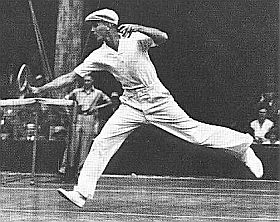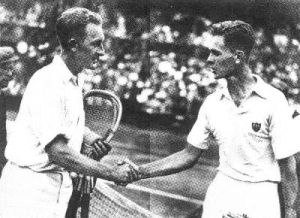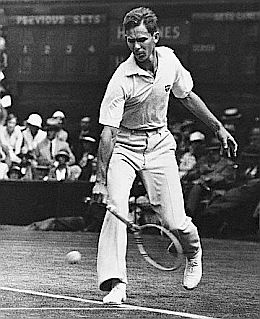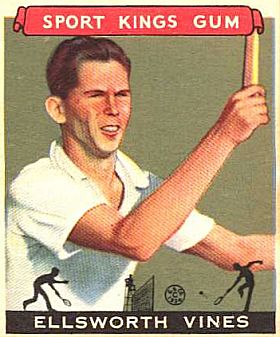
Tennis star Ellsworth Vines pitching Camel cigarettes in an October 1934 ‘Popular Science’ magazine ad.
The magazine ad at right shows Vines in a full-page endorsement for the cigarette in his tennis attire, depicted as smoking a cigarette at the end of a tennis match. However, it is not known whether Vines in fact was a smoker, as endorsing stars often posed with cigarettes to do advertising, but were not actual smokers.
This ad, in any case, appeared in Popular Science magazine October 1934, and perhaps other publications as well.
As this is written in mid-2010, it appears especially odd and out of place to see a tennis player hawking cigarettes — something about all those tennis “whites” and the game’s clean and healthy image. Plus today’s media offerings of young and vital tennis players, portray them as epitomes of health and model athletes. What’s more, having a cigarette after an exhausting tennis match is probably the last thing you’d expect a tennis player in current times to actually do, or espouse for anyone else to do.
Yet, in the 1930s — and through the 1960s in fact — athletes endorsing tobacco products was not uncommon. Tobacco companies recruited them as they did Hollywood film stars and other celebrities.
Sports star association with tobacco products began in the late 19th century, when tobacco companies started enclosing small trading cards of baseball and other sports players in their cigarette and cigar packets (see Honus Wagner story, for example). The cards generally included a photograph or artist rendering of the popular players of the day. Movie stars and other famous people were also used on the trading cards.Tobacco companies in the late 1920s and 1930s also began striking deals with actors and film studios, generally trying to associate their product with the famous and well known — those seen as trend setters and having an influence on the general public. By then even some notable medical publications were enlisted for tobacco advertising.
In November 1933, for example, the Journal of the American Medical Association published its first advertisement for cigarettes — Chesterfield — a practice that continued for 20 years. TAlso in 1933, Chesterfield began running ads in the New York State Journal of Medicine. So, in the context of that era, seeing a tennis star in the 1930s with cigarette in hand did not seem out of place.

Ellsworth Vines in action at Wimbledon in 1932.
You’ll enjoy this pleasing “Energizing Effect”
When you’ve used up your energy – smoke a Camel and notice how you feel your flow of natural energy snap back.
This experience, long known to Camel smokers, has now been confirmed by a famous New York research laboratory. Camel smokers enjoy a positive “energizing effect” …a healthful and delightful release of natural, vibrant energy. A typical Camel experience is this, Ellsworth Vines, Jr. speaking —
“Championship tennis is one of the fastest of modern sports. After four or five sets, you sometimes feel that you just can’t take another step. That’s when a Camel tastes like a million dollars. Not only does the rich, mellow fragrance appeal to my taste, but Camels have a refreshing way of bringing my energy up to a higher level. And I can smoke all the Camels I want, for they don’t interfere with my nerves.”
So, whenever you want a “lift,” just smoke a Camel. You can smoke them steadily. For the finer, MORE EXPENSIVE TOBACCOS in Camels never get on your nerves.
CAMEL’S Costlier Tobaccos never get on your Nerves. “Get a Lift with a Camel!”

Jack Crawford and Ellsworth Vines (right) greeting one another after a match at Wimbledon, 1932.

Ellsworth Vines in play vs. Henri Cochet of France at Wimbledon, May 7, 1933.
In fact, in 2004, Vines’ son, Ellsworth Vines III, wrote a book about his father titled, The Greatest Athlete of All Time, a story he documented with letters and interviews with other sports figures and sports writers. Among the latter, Jim Murray of the Los Angeles Times, would say of Vines: “They didn’t make a game he couldn’t play. He went to college on a basketball scholarship and he hit a baseball so hard his high school coach used to say it didn’t come down for two innings. For one given game, he was probably the best who ever played the game of tennis, his talents were raw power. Athletes from other sports have invaded the golf field but Elly Vines didn’t just join the pro golfers; he beat them.”

Ellsworth Vines also appeared in this 1935 Camel cigarette ad (upper lefthand corner), which featured a range of athletes all endorsing the cigarette.
For additional stories on tobacco advertising at this website, see for example: “Al Jolson & Luckies, 1928-1940s” (Hollywood & cigarette advertising); “Babe Ruth & Tobacco, 1920s-1940s;” “Wayne For Camels,1950s” (actor John Wayne cigarette ads); “Gifford For Luckies, 1961-1962” (Frank Gifford, football star, in cigarette ad); and, “21 of 23 Giants…Smoke Camels” (promotional ad using 1933 World Series champs). See also the “Madison Avenue” category page for other ad stories.
Thanks for visiting — and if you like what you find here, please make a donation to help support the research and writing at this website. Thank you. — Jack Doyle
|
Please Support Thank You |
___________________________
Date Posted: 19 July 2010
Last Update: 12 May 2018
Comments to: jdoyle@pophistorydig.com
Twitter: https://twitter.com/PopHistoryDig
Article Citation:
Jack Doyle, “Vines for Camels, 1934-1935,”
PopHistoryDig.com, July 18, 2010.
___________________________
Sources, Links & Additional Information
Ad: “Get a Lift With a Camel!,” Popular Science, October 1934, from, ModernMechanix.com, August 6, 2007.“Ellsworth Vines,” Wikipedia.org.
“Sport: Davis Cup,” Time, Monday, August 1, 1932.
Henry R. Ilsley, “Vines Tops Allison in Three-Set Final; Wins in Newport Singles for Second Year in Row…,”New York Times, Sunday, August 21, 1932, p. S-1.
Allison Danzig, “12,000 See Vines Vanquish Cochet; French Ace Defeated, 6-4, 4-6, 6-3, 6-3, in His First U.S. Appearance As a Pro,” New York Times, Tuesday, February 20, 1934, Sports, p. 27.
Allison Danzig, “Twenty Service’ Aces Are Scored by Vines in Routing Perry on Garden Court; Vines Wins Match in Straight Sets,” New York Times, Tuesday, May 4, 1937, p. 33.
Jack Kramer with Frank Deford, The Game, My 40 Years in Tennis, 1979.
Scott Olstad, “A Brief History Of Cigarette Advertising,” Time, Monday, June 15, 2009.
“Ellsworth Vines,” French website.
_________________________

